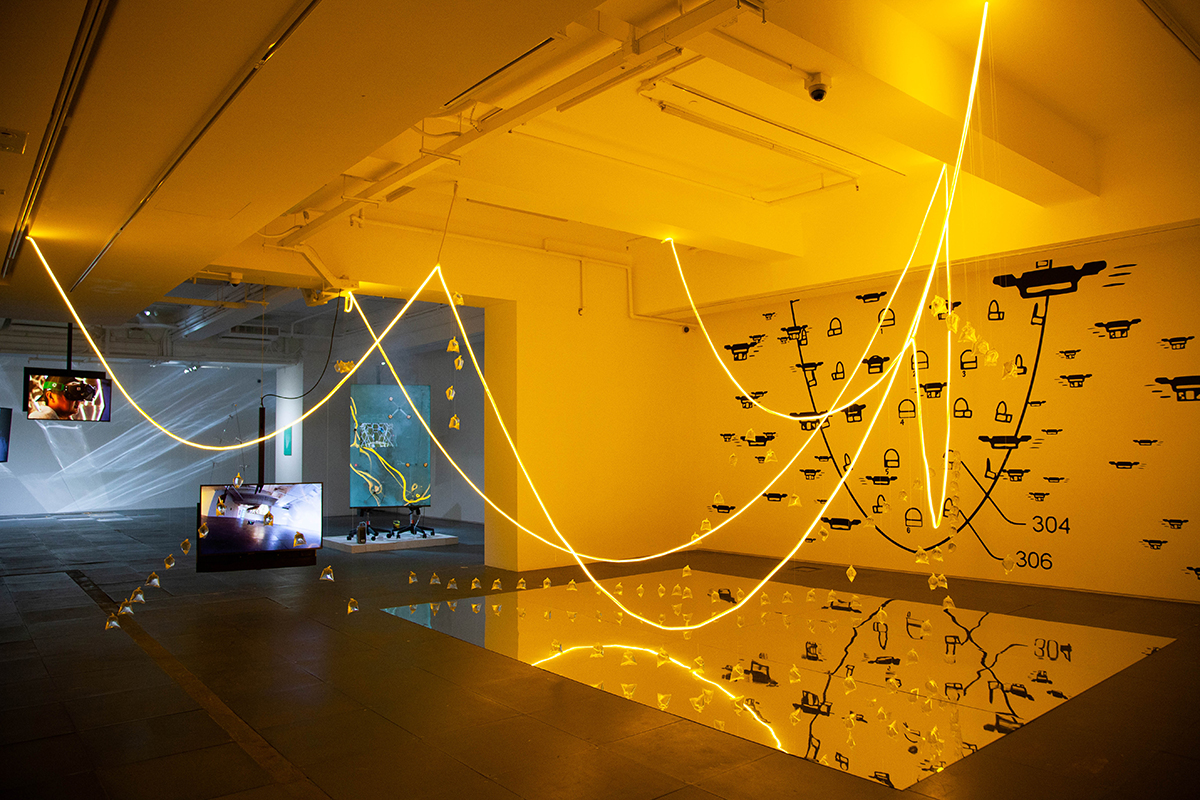
Drones are priority visitors at de Sarthe gallery, where artists Andrew Luk and Samuel Swope have collaborated to create a full-fledged obstacle course for first-person-view (FPV) drone racing.
Ready\Set\Fulfill highlights the correlation between speed and advancement. Experienced FPV pilots – who view their flights as though from inside the drone, via a video feed to goggles, dissipating the line between human and machine – were invited to participate in the races. Though they were only present during the opening and on a few other occasions, their efforts are showcased on screens interspersed throughout the space. The format evokes an intrinsic competitive drive, deploying a sense of urgency in addressing our obsession with acceleration and the ways in which technology enables it.
As the drones take flight, they first encounter the neon-lit inverted arches of As hangs the flexible light rope (all works 2021), a visual reference to the catenary curve used by Antoni Gaudí to form the signature shapes of his buildings (itself adapted from a technique bees use to create the contour of the outer walls of their hives). Reflected over a mirrored surface installed in the floor, the arcs, composed of led light ropes, are visually imposed upon Inverted Fulfillment, a vinyl-cut recreation of Amazon’s 2017 patent for ‘beehive’ drone-delivery fulfilment centres imprinted on the wall behind. The convergence of art, architecture, technology and the digitalisation of the human experience is literally reflected in the abovementioned works, bringing visions of a future utopia closer to the present. The Amazon patent’s technical rendering relies upon the beehive in both form and function. Consisting of a tower with openings across several levels, through which drones can rapidly enter and exit, the model appears designed to promote efficiency, velocity, productivity and, ultimately, profitability.

The hive is continually referenced here, an acknowledgement of its enduring prominence in architectural and social thinking. Glass Curtain Dive (22.248808,114.1630336), a video installation showcasing the drone’s perspective as it streams down the surface of the glass-walled skyscraper housing the gallery, simultaneously alludes to the structural concept pioneered by Mies van der Rohe, to workforce visibility and to drone-based surveillance. Perhaps unintentionally, it also highlights the ambiguous nature of seemingly interchangeable glass walls and digital surfaces.
The pitfalls of illusion in this densely layered exhibition culminate in Honeycomb Accelerator, an impressive installation implying an elongated portal to a digital beehive. Lit with LED light strips and lined with reflective surfaces mirroring and mimicking the interior of a beehive (with a technological twist), it features drones whirring through the surface’s deceptive multiplicity. But again, it is an illusion that challenges perceived reality.
A year in the making, the show has a topical resonance. Rapid digital development driving the discourse surrounding the convergence of art and technology is seemingly filled with new potential. Most effectively Ready\Set\Fulfill explores how psychology and behaviour are conditioned by environment – both physical and digital – in the process revealing the latest iteration of the persistent exchange between nature and technology.
Ready\Set\Fulfill at de Sarthe, Hong Kong, 13 March – 8 May
First published in the May 2021 issue of ArtReview